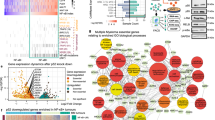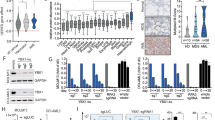Abstract
Transforming growth factor β (TGF-β) is a pluripotent cytokine that controls key tumour suppressive functions1,2,3, but cancer cells are often unresponsive to it1,4. The promyelocytic leukaemia (PML) tumour suppressor of acute promyelocytic leukaemia (APL) accumulates in the PML nuclear body, but cytoplasmic PML isoforms of unknown function have also been described5,6. Here we show that cytoplasmic Pml is an essential modulator of TGF-β signalling. Pml-null primary cells are resistant to TGF-β-dependent growth arrest, induction of cellular senescence and apoptosis. These cells also have impaired phosphorylation and nuclear translocation of the TGF-β signalling proteins Smad2 and Smad3, as well as impaired induction of TGF-β target genes. Expression of cytoplasmic Pml is induced by TGF-β. Furthermore, cytoplasmic PML physically interacts with Smad2/3 and SARA (Smad anchor for receptor activation) and is required for association of Smad2/3 with SARA and for the accumulation of SARA and TGF-β receptor in the early endosome. The PML–RARα oncoprotein of APL can antagonize cytoplasmic PML function and APL cells have defects in TGF-β signalling similar to those observed in Pml-null cells. Our findings identify cytoplasmic PML as a critical TGF-β regulator, and further implicate deregulated TGF-β signalling in cancer pathogenesis.
This is a preview of subscription content, access via your institution
Access options
Subscribe to this journal
Receive 51 print issues and online access
$199.00 per year
only $3.90 per issue
Buy this article
- Purchase on Springer Link
- Instant access to full article PDF
Prices may be subject to local taxes which are calculated during checkout




Similar content being viewed by others
References
Derynck, R., Akhurst, R. J. & Balmain, A. TGF-β signaling in tumor suppression and cancer progression. Nature Genet. 29, 117–129 (2001)
Siegel, P. M. & Massague, J. Cytostatic and apoptotic actions of TGF-β in homeostasis and cancer. Nature Rev. Cancer 3, 807–820 (2003)
Attisano, L. & Wrana, J. L. Signal transduction by the TGF-β superfamily. Science 296, 1646–1647 (2002)
Kim, S. J. & Letterio, J. Transforming growth factor-β signaling in normal and malignant hematopoiesis. Leukemia 17, 1731–1737 (2003)
Jensen, K., Shiels, C. & Freemont, P. S. PML protein isoforms and the RBCC/TRIM motif. Oncogene 20, 7223–7233 (2001)
Fagioli, M. et al. Alternative splicing of PML transcripts predicts coexpression of several carboxy-terminally different protein isoforms. Oncogene 7, 1083–1091 (1992)
Melnick, A. & Licht, J. D. Deconstructing a disease: RARα, its fusion partners, and their roles in the pathogenesis of acute promyelocytic leukemia. Blood 93, 3167–3215 (1999)
Salomoni, P. & Pandolfi, P. P. The role of PML in tumor suppression. Cell 108, 165–170 (2002)
Kastner, P. et al. Structure, localization and transcriptional properties of two classes of retinoic acid receptor α fusion proteins in acute promyelocytic leukemia (APL): structural similarities with a new family of oncoproteins. EMBO J. 11, 629–642 (1992)
Ferbeyre, G. et al. PML is induced by oncogenic ras and promotes premature senescence. Genes Dev. 14, 2015–2027 (2000)
Pearson, M. et al. PML regulates p53 acetylation and premature senescence induced by oncogenic Ras. Nature 406, 207–210 (2000)
Katakura, Y., Nakata, E., Miura, T. & Shirahata, S. Transforming growth factor βtriggers two independent-senescence programs in cancer cells. Biochem. Biophys. Res. Commun. 255, 110–115 (1999)
Tsukazaki, T., Chiang, T. A., Davison, A. F., Attisano, L. & Wrana, J. L. SARA, a FYVE domain protein that recruits Smad2 to the TGFβ receptor. Cell 95, 779–791 (1998)
Di Guglielmo, G. M., Le Roy, C., Goodfellow, A. F. & Wrana, J. L. Distinct endocytic pathways regulate TGF-β receptor signalling and turnover. Nature Cell Biol. 5, 410–421 (2003)
Panopoulou, E. et al. Early endosomal regulation of Smad-dependent signaling in endothelial cells. J. Biol. Chem. 277, 18046–18052 (2002)
Hayes, S., Chawla, A. & Corvera, S. TGF βreceptor internalization into EEA1-enriched early endosomes: role in signaling to Smad2. J. Cell. Biol. 158, 1239–1249 (2002)
Testa, U. et al. PML/RAR α + U937 mutant and NB4 cell lines: retinoic acid restores the monocytic differentiation response to vitamin D3. Cancer Res. 54, 4508–4515 (1994)
Grignani, F. et al. The acute promyelocytic leukemia-specific PML–RAR α fusion protein inhibits differentiation and promotes survival of myeloid precursor cells. Cell 74, 423–431 (1993)
Testa, U. et al. Transforming growth factor-β potentiates vitamin D3-induced terminal monocytic differentiation of human leukemic cell lines. J. Immunol. 150, 2418–2430 (1993)
Zhu, J., Chen, Z., Lallemand-Breitenbach, V. & de The, H. How acute promyelocytic leukaemia revived arsenic. Nature Rev. Cancer 2, 705–713 (2002)
Turelli, P. et al. Cytoplasmic recruitment of INI1 and PML on incoming HIV preintegration complexes: interference with early steps of viral replication. Mol. Cell 7, 1245–1254 (2001)
Cordenonsi, M. et al. Links between tumor suppressors: p53 is required for TGF-β gene responses by cooperating with Smads. Cell 113, 301–314 (2003)
Gurrieri, C. et al. Loss of the tumor suppressor PML in human cancers of multiple histologic origins. J. Natl Cancer Inst. 96, 269–279 (2004)
Howe, J. R. et al. Mutations in the SMAD4/DPC4 gene in juvenile polyposis. Science 280, 1086–1088 (1998)
Miyaki, M. et al. Higher frequency of Smad4 gene mutation in human colorectal cancer with distant metastasis. Oncogene 18, 3098–3103 (1999)
Wang, Z. G. et al. Role of PML in cell growth and the retinoic acid pathway. Science 279, 1547–1551 (1998)
Kang, H. Y. et al. From transforming growth factor-β signaling to androgen action: identification of Smad3 as an androgen receptor coregulator in prostate cancer cells. Proc. Natl Acad. Sci. USA 98, 3018–3023 (2001)
Lin, H. K., Wang, L., Hu, Y. C., Altuwaijri, S. & Chang, C. Phosphorylation-dependent ubiquitylation and degradation of androgen receptor by Akt require Mdm2 E3 ligase. EMBO J. 21, 4037–4048 (2002)
Kurokawa, M. et al. The oncoprotein Evi-1 represses TGF-β signalling by inhibiting Smad3. Nature 394, 92–96 (1998)
Escola, J. M., Grivel, J. C., Chavrier, P. & Gorvel, J. P. Different endocytic compartments are involved in the tight association of class II molecules with processed hen egg lysozyme and ribonuclease A in B cells. J. Cell Sci. 108, 2337–2345 (1995)
Acknowledgements
We are grateful to C. Chang, K. S. Chang, H. Y. Kang, Y. B. Kang, S. W. Lowe, P. G. Pelicci, M. Reiss, T. Sollner and J. L. Wrana for reagents and advice. Special thanks to all the members of the Pandolfi laboratory for comments and discussion. We also thank T. Merghoub and I. Guernah for technical help, R. Hobbs and L. DiSantis for critical reading and preparation of the manuscript. This work was supported by National Institutes of Health grants to P.P.P.
Author information
Authors and Affiliations
Corresponding author
Ethics declarations
Competing interests
The authors declare that they have no competing financial interests.
Supplementary information
Supplementary Figure 1
cPML is induced by TGF-β1 and exhibits a punctate cytoplasmic localization pattern. (PPT 790 kb)
Supplementary Figure 2
Role of cPml in TGF-β1 signal transduction. (PPT 1480 kb)
Supplementary Figure 3
Determination of the cPML and Smad3 regions required for their physical interaction. (PPT 407 kb)
Supplementary Figure 4
cPML, SARA, and Smad3 colocalize in cytoplasmic region. (PPT 1186 kb)
Supplementary Figure 5
Colocalization of Smad3 and SARA is impaired in Pml-/- MEFs. (PPT 222 kb)
Supplementary Figure 6
Localization of endogenous TbRI to the early endosome is impaired in Pml-/- MEFs. (PPT 763 kb)
Supplementary Figure 7
Endogenous cPml colocalizes with EEA1. (PPT 354 kb)
Supplementary Figure 8
cPML interacts with TβRI and TβRII. (PPT 196 kb)
Rights and permissions
About this article
Cite this article
Lin, HK., Bergmann, S. & Pandolfi, P. Cytoplasmic PML function in TGF-β signalling. Nature 431, 205–211 (2004). https://doi.org/10.1038/nature02783
Received:
Accepted:
Issue Date:
DOI: https://doi.org/10.1038/nature02783
This article is cited by
-
The functional multipotency of transforming growth factor β signaling at the intersection of senescence and cancer
Cellular and Molecular Life Sciences (2022)
-
PSPC1 is a new contextual determinant of aberrant subcellular translocation of oncogenes in tumor progression
Journal of Biomedical Science (2021)
-
PML Suppresses Influenza Virus Replication by Promoting FBXW7 Expression
Virologica Sinica (2021)
-
Signatures of co-deregulated genes and their transcriptional regulators in colorectal cancer
npj Systems Biology and Applications (2020)
-
Collagen density regulates the activity of tumor-infiltrating T cells
Journal for ImmunoTherapy of Cancer (2019)
Comments
By submitting a comment you agree to abide by our Terms and Community Guidelines. If you find something abusive or that does not comply with our terms or guidelines please flag it as inappropriate.



